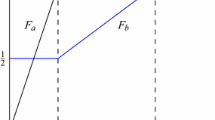Abstract
We analyze a model of conflict with endogenous choice of effort, where subsets of the contenders may force the resolution to be sequential: First the alliance fights it out with the rest and – in case they win – later they fight it out among themselves. For three-player games, we find that it will not be in the interest of any two of them to form an alliance. We obtain this result under two different scenarios: equidistant preferences with varying relative strengths, and varying vicinity of preferences with equal distribution of power. We conclude that the commonly made assumption of super-additive coalitional worth is suspect.
Similar content being viewed by others
REFERENCES
Baik, K.-H. and Lee, S. (2001), Strategic groups and rent dissipation, Economic Inquiry 39(4), 672–684.
Bloch, F. (1997), Non-cooperative models of coalition formation in games with spillovers, New Directions in the Economic Theory of the Environment edited by Carraro and Sinischalco, Cambridge University Press.
Bloch, F., Sánchez-Pagés, S. and Soubeyran, R. (2002), When does universal peace prevail? Secession and group formation in rent seeking contests and policy conflict, mimeo, GREQAM, Marseille.
Esteban, J. and Ray, D. (1999), Conflict and distribution, Journal of Economic Theory 87, 379–415.
Esteban, J. and Ray, D. (2001), Free riding and the group size paradox, American Political Science Review 95, 663–672.
Esteban, J. and Sákovics, J. (2000), Temporary Alliance Formation: Endogenous Sequencing in Conflict Games, Discussion Paper, Instituto de Estudios Económicos de Galicia Pedro Barrié de la Maza.
Garfinkel, M.R. (2002), Stable alliance formation in distributional conflict, mimeo, University of California at Irvine, June. Forthcoming in the European Journal of Political Economy.
Greenberg, J. (1994), Coalition structures, Handbook of Game Theory with Economic Applications edited by Aumann and Hart, Chapter 37, North Holland: Elsevier Science.
Niou, E. and Tan, G. (1997), A Theory of Alliance Formation, mimeo, Duke University, August.
Noh, S.J. (2002), Resource distribution and stable alliances with endogenous sharing rules, European Journal of Political Economy, 18, 129–151.
Olson, M. (1965), The Logic of Collective Action, Harvard University Press.
Ray, D. and Vohra, R. (1997), Equilibrium binding agreements, Journal of Economic Theory 73(1), 30–78.
Ray, D. and Vohra, R. (1999), A theory of endogenous coalition structures, Games and Economic Behavior 26, 286–336.
Skaperdas, S. (1998), On the formation of alliances in conflict and contests, Public Choice 96, 25–42.
Tan, G. and Wang, R. (1999), Endogenous Coalition Formation in Rivalry, mimeo, University of British Columbia, April.
Yi, S.-S. and Shin, H. (2000), Endogenous formation of research coalitions with spillovers, International Journal of Industrial Organization 18, 229–256.
Author information
Authors and Affiliations
Rights and permissions
About this article
Cite this article
Esteban, J., Sákovics, J. Olson VS. Coase: Coalitional Worth in Conflict. Theory and Decision 55, 339–357 (2003). https://doi.org/10.1023/B:THEO.0000047490.12475.03
Issue Date:
DOI: https://doi.org/10.1023/B:THEO.0000047490.12475.03




